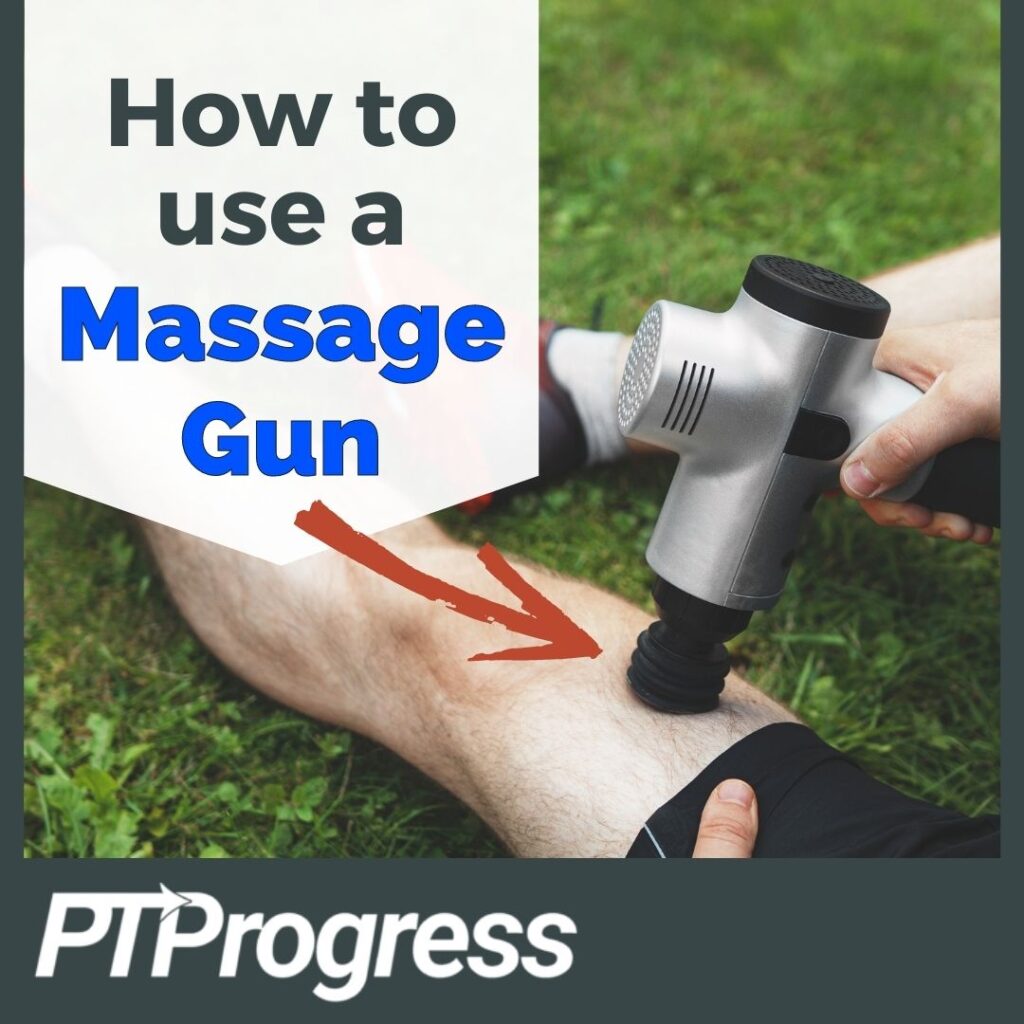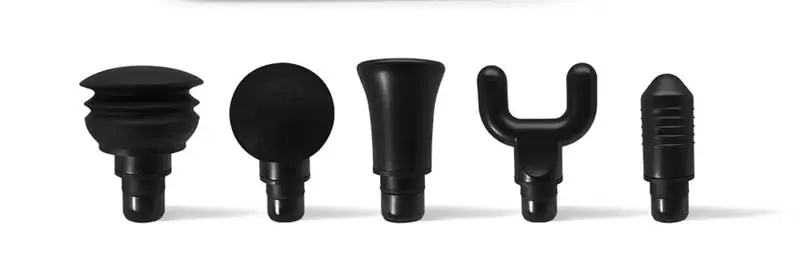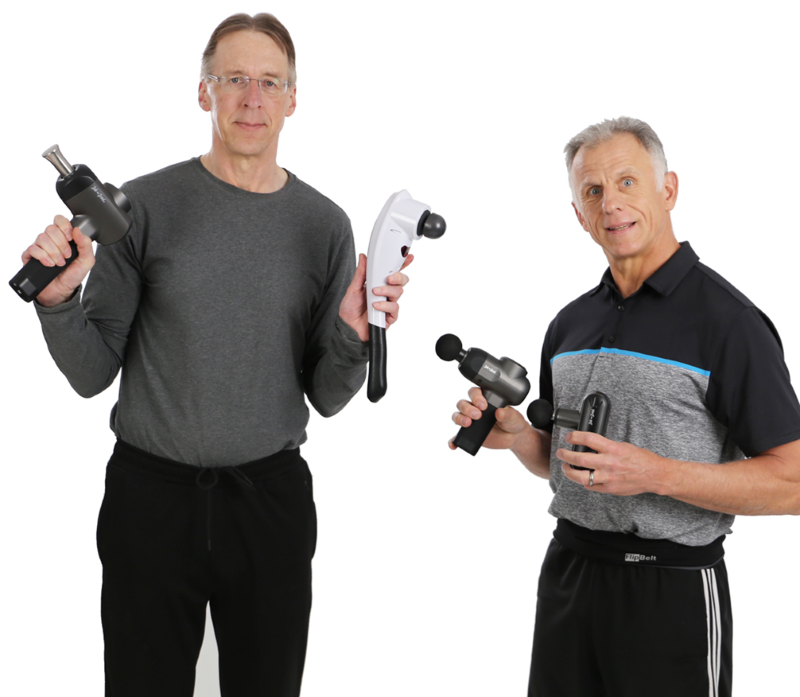
The latest health gadget to sweep the nation puts pain relief squarely in your hands. Not only is it effective, it’s easy to use and relatively inexpensive. What am I talking about? A massage gun—a pistol-sized massager you manipulate yourself to treat sore and achy muscles.
Below I’ll give you an overview of this neat device: how it works, why it’s so therapeutic, and how to use a massage gun the right way.
What is a Massage Gun?
A massage gun is a handheld device that percusses back and forth at variable speeds and depths. As the gun pulsates, you can guide it along a muscle, across muscles, in a circle over a wide area, or simply on one target spot for a punchy, deep-tissue massage.
The Anatomy of a Massage Gun
All massage guns generally work the same way, but there are a few details to know about and features to look for when shopping for the best massage gun.
Amplitude refers to the depth at which a massage gun’s head pulses. Meaning, if you hold the gun steady to your thigh, how deep will it push on your leg? To emulate a deep-tissue massage, pick a massage gun with a greater amplitude, which will also help you treat bigger, bulkier muscle groups that tend to get sore after exercise.
PPM stands for “pulsations per minute,” which some manufacturers refer to as RPM, or “rotations per minute.” Most guns throb to the beat of 2000-3200 PPM, with higher speeds typically delivering a more intense massage.
Attachments, or “heads,” are the interchangeable accessories that come with your massage gun. A great gun will give you a good massage no matter the attachment. But by manipulating which head you use for which muscle group, you can fine-tune your massage gunning like a true pro.
Battery life is worth mentioning as well. No one wants to massage their back with an electrical cord trailing behind them, so you’ll only find massage guns with rechargeable batteries. Not all batteries work the same, however, so consider how often you’ll be using your gun and for how long. A good battery life lasts at least 2 hours on a single charge.
My Favorite Massage Gun
- LIGHTWEIGHT & PORTABLE DESIGN- Bob and Brad massage gun is only 1.5lbs, easy to carry anywhere and easy to pack into any gym bag in the home gym...
- POWERFUL PERFORMANCE - Brushless motor, super blocking torque energy output without interruption and dual shaft drive structure offers stable...
Why Use a Massage Gun?
Besides being the proud owner of a sleek fitness gadget, there are many reasons to have and use a massage gun.
First, a massage gun can help relax tense muscles. After a few minutes of deep-tissue percussion, you’ll practically hear your muscles sighing with relief. Taking time to massage your legs and back is a great way to wind down for the night.
Many people use a massage gun for its therapeutic capabilities. As a Physical Therapist, I often recommend massage guns to my patients for fast, at-home pain relief. Whether it’s achy joints or spastic muscles, a massage gun can safely soothe many different types of musculoskeletal ailments.
Plus, a relaxed muscle recovers and repairs better, which is important for many of my patients working to rehabilitate a post-operative joint or regain mobility after an injury.
Muscle knots are hard to get rid of, but a decent massage gun will loosen those knots as quickly as they developed. Without a proper massage, you might not even realize that those tight muscles in your upper shoulders are causing your persistent tension headaches. Therefore, by drilling on a trigger point, a massage gun can help relax not just the target spot but proximal muscle groups as well.
Finally, even if you’re enviably limber and loose, a massage gun can help your muscles recover from an injury or a tough workout. Delayed-onset muscle soreness is the fancy term for how your legs feel the day after you did too many lunges. Ending your workout with a massage gun session will help you reduce that delayed-onset muscle soreness and see better results in the gym.
How to Use a Massage Gun
Powering on and pulling the trigger are pretty easy to do. But to get the most out of your massage gun, consider the following steps.
- Aim
Figure out what exactly you’re gunning for. Is it knee pain? A tweaky back? Sore quads? A knot in your neck? The objective of your massage treatment will determine what muscles you massage, what techniques to use, and what heads to attach.
- Sustain
Massage for at least 30 seconds per muscle group, though 2-3 minutes is ideal. It may take time for you to get used to the force and speed of a massage gun, so break it up by hitting other spots if you need to let those muscles relax.
- Hydrate
Muscles are 80% water, and a well-hydrated muscle is a happy muscle. You need water to flush out lactic acid, repair tissue, and power your recovery, so be sure to drink water before and after you use your massage gun.
Finally, make sure you’re comfortable. Don’t try to “tough it out” if a high-speed setting or blunt attachment is causing pain.
How to Use a Massage Gun Attachment
To modify, intensify, or pinpoint your massage gun experience, try experimenting with various attachments. Most guns come with at least a couple heads of different shapes, which will slightly alter the depth, breadth, or “give” of your gun’s pulsating percussion.
PSA: a massage gun is for muscles, not bones. So don’t use a massage gun near a bony part of your body—such as your spine, ankle bones, or clavicle—unless you have a gentle device or a softening attachment.
The gun I have at home came with the following 5 popular attachments, pictured here from left to right :

- Air Cushion
- Ball
- Flat Round
- Fork
- Bullet
Let’s consider what each of these heads can do for you, in descending order of intensity.
1. The Fork Attachment
Best for: Large, tight muscles; deep tissue; recovery
This is a very popular attachment that comes with nearly every massage gun. I like using it on larger muscle groups such as my quads, hamstrings and glutes because it provides more coverage (twice, rather) than other attachments.
Resist the temptation to straddle the fork head along your spine. There are plenty of ways to treat knots along the mid-back, and delivering an unintentional blow to your paraspinal bones is not one of them.
2. The Bullet Attachment
Best for: Large tight muscles; deep tissue; target spots
It’s only natural for a massage gun to come with a bullet. This single-point head is useful for targeting trigger points and loosening tough knots.
Although it may be too intense for more sensitive areas such as the forearm, the bullet head is perfect for the leg and back muscles, or anywhere you need a deep tissue massage.
3. The Flat Round Attachment
Best for: Medium to large muscles; sore muscles
The flat round attachment is a unique shape with a versatile application. The round circle at the end can cover a wide area for large muscle groups, while the flat top allows for maximal force.
Because it’s not pointed, the flat round attachment can’t go as deep as the bullet or fork attachments. However, its moderate percussion is perfect for bulky muscles such as the calf or biceps.
4. The Ball Attachment
Best for: Sensitive muscle groups; all areas
Whether foam or plastic, the ball attachment allows you to scale the intensity of your massage with a simple tilting motion. Instead of hitting the targeted area head-on, you can rotate the gun around its point for a cross-friction massage, useful for tender areas such as the forearm and foot as well as heavy-hitters like your quads and glutes.
5. The Air Cushion (Padded Round) Attachment
Best for: Sensitive and bony areas
My favorite massage head, the air cushion uses subtle padding to modify your gun’s percussive power. With this attachment, you can feel more confident approaching bony areas such as the spine, wrists, and even the upper neck.
But the padded round isn’t a total softie; it can still deliver powerful force to sore muscles. Overall, I consider it one of the most comfortable attachments, which is why it’s my go-to piece.
What is the Best Massage Gun?
If you want to try out each of these attachments, you can find them for sale with any of Bob and Brad’s massage guns.
Two of the most famous PTs on the internet, Bob and Brad have made some excellent massage guns—three, in fact, all which I have reviewed right here on the blog. The best massage gun is the one that suits your body type, meets your needs, or fits your bill. Maybe the C2 massage gun is exactly what you’re looking for: standard size, a wide range of settings, and reliable battery power.

If you need a gun that will go soft on delicate tissue, such as the small muscles in your neck and hands, the Mini gun might be more your style. This gun isn’t as powerful as the C2, but it gets pretty close, allowing you to soothe all muscles big and small.
Finally, check out the X6 Pro gun if you’re a go-big-or-go-home kind of person. Yes, it is bigger than the other two in size—which in some ways makes it easier to handle—but it also packs a bigger punch: greater amplitude and higher speeds.
Whether you need to iron out your quads or loosen a kink in your neck, Bob and Brad have the gun for the job. Having used, purchased, and loved all three, I can attest that the quality of these guns far exceeds their price—which isn’t the case for the cheap knockoff guns you’ll find elsewhere. Just saying.
How to Use a Massage Gun: Final Thoughts
Simple and safe, massage gun therapy is easy to do at home or on the road, helping you relax your muscles and relieve pain wherever you are. Instead of spending hundreds of dollars every month on regular massage sessions, you can get similar pain-relief results with just a massage gun!
However, a massage gun isn’t a silver bullet, and it can’t take the place of essential exercise. To truly address chronic pain, you’ll likely need several techniques—such as lifestyle changes, regular stretching, and guided exercise—with massage gun therapy being just one (albeit, cool) piece to that puzzle.
My Favorite Massage Gun
- LIGHTWEIGHT & PORTABLE DESIGN- Bob and Brad massage gun is only 1.5lbs, easy to carry anywhere and easy to pack into any gym bag in the home gym...
- POWERFUL PERFORMANCE - Brushless motor, super blocking torque energy output without interruption and dual shaft drive structure offers stable...


